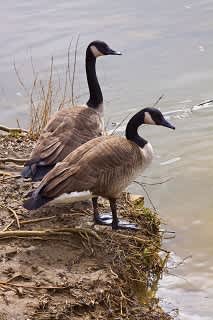Even with Dry Conditions, Waterfowl Season Promising for Kentucky’s Nov. 22 Opening Day

The table is set for a wonderful Thanksgiving dinner. The dressing awaits, the cook just put a spoon into the green bean and sweet potato casseroles, the gravy steams and pumpkin pies cool on racks. All that is needed is the turkey.
Waterfowl seasons open Thanksgiving Day, Nov. 22, and the season is similar to this dinner. The conditions are in place for a productive waterfowl season; all that is needed is water.
“We are still hurting for water across the state,” said Rocky Pritchert, migratory bird program coordinator for the Kentucky Department of Fish and Wildlife Resources. “The Ohio River is low, reservoirs are low, farm ponds are low. Conditions are pretty even throughout Kentucky.”
The drought that gripped a large chunk of Kentucky caused these low water conditions, but also provided a potential feast for waterfowl if rains fall.
“Areas that are normally moist have grown up in abundant natural vegetation from the drought,” Pritchert explained. “If we get water, we will hold birds for a long time because there is lots of food out there for them to eat. We should have a good opener for waterfowl season.”
The recent fronts pushed ducks from the north into the traditional waterfowl areas in the Purchase Region and along the Ohio River.
“Good numbers of ducks are showing up at Ballard Wildlife Management Area (WMA) in western Kentucky,” Pritchert said. “The resident Canada goose population had a good reproductive year. We may see more geese to the south this year because of the lack of food from the drought in the northern tier states. Those states were more impacted by the drought, so we may see more goose migration from the north this season. We hope to get a better push than the last two years.”
Mike Morton, area manager for Sloughs WMA in Henderson and Union counties, said the area holds several thousand white-fronted geese, snow geese and Canada geese along with 3,000 or so ducks. “It is fairly average for this time of year,” he explained. “We have a few more snow geese than we usually do. White-fronted geese have made up the majority of goose numbers on the area in winter for the last four years. If we can get snow cover up north, it will really roll the geese out to us.”
Waterfowl hunters need to remember that both duck and goose seasons open statewide on the same day, Nov. 22 this year, except in the Northeastern Goose Zone where Canada goose season opens Jan. 1. Some wildlife management areas may have different opening dates.
Hunters may take only one brant this year as part of their five goose daily bag limit. Brant are rare in Kentucky. However, hunters may take up to four scaup as part of the six duck daily bag limit, an increase of two scaup from last year.
“Scaup numbers have recovered to the point to allow for additional harvest,” Pritchert explained. “Scaup are usually associated with larger bodies like Kentucky Lake and Lake Barkley.”
To get their duck limits, hunters may want to target farm ponds. Many ponds remain low from the drought, but rainfall will create an ideal hunting situation.
“The exposed banks of those farm ponds are now grown up with a variety of emergent vegetation such as barnyard and panic grass and smart weed,” Pritchert said. “If we get water on those plants, there is a potential to hold a lot of ducks.”
Duck, coot and merganser season closes Nov. 24, but opens again Dec. 5 before closing on Jan. 27, 2013. Statewide goose seasons close Jan. 31, 2013 with the exception of the snow goose conservation order season. For more information on waterfowl season, pick up a copy of the 2012-2013 Kentucky Hunting Guide for Waterfowl, available wherever hunting licenses are sold. You may request a copy by calling 1-800-858-1549 or view a printable copy at the Kentucky Fish and Wildlife webpage at fw.ky.gov.

